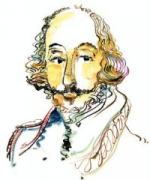|
This section contains 3,609 words (approx. 13 pages at 300 words per page) |

|
SOURCE: "Shakespeare's Clowns and Fools," in Shakespeare Set Free: Teaching Romeo and Juliet, Macbeth and A Midsummer Night's Dream, edited by Peggy O'Brien, Washington Square Press, 1993, pp. 19-24.
Below, Skura surveys Shakespeare's use of clowns in his plays, and their popularity with both Elizabethan and modern audiences.
For a long while Shakespeare's clowns were an embarrassment to everybody, and they were censored from productions. Lear's fool, for example, was left out of every one of the many eighteenth-century performances of King Lear. Producers in the nineteenth century kept Macbeth's porter in the play, but they cut his lines to "Knock, knock, knock." Twentieth-century productions have at times imposed their own censorship on Shakespeare, invoking aesthetic if not moral justifications. The clowns in Romeo and Juliet and Othello are occasionally removed from modern productions, for example. On the whole, however, in our era clowns have been rescued. We find...
|
This section contains 3,609 words (approx. 13 pages at 300 words per page) |

|


